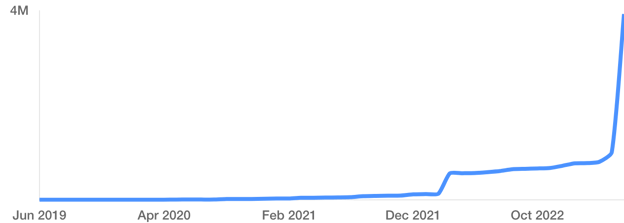If you’ve visited cdr.fyi recently, their graph of durable carbon removal sales has no doubt caught your eye:
Total sales from CDR projects (courtesy cdr.fyi)

A massive month has nearly quadrupled the size of the durable carbon removal industry, boosting it from about $1 million at the beginning of April to around $3.9 million as of May 26, 2023. By “durable removal”, we mean techniques capable of storing carbon for 1000+ years. The nearly $3 million in additional sales is highlighted by four deals:
|
Purchaser
|
Supplier
|
Tonnes
|
|
Microsoft
|
Ørsted
|
2,760,000
|
|
JPMorgan
|
Multiple
|
800,000
|
|
NextGen
|
Multiple
|
200,000
|
|
Frontier
|
Charm Industrial
|
112,000
|
These sales encompass several methods including biomass capture and storage, direct air capture, and biochar. Beyond Ørsted and Charm Industrial, other suppliers include Climeworks, 1PointFive, Summit Carbon Solutions, and Carbo Culture. The financial terms of the Microsoft purchase were not disclosed, but the other three deals fall between $200-500 per tonne.
The rising pace of CDR purchases is good news, but it is important to remember that these are forward purchase agreements. Of the nearly 4 million tonnes of durable CDR that has been purchased, only about 1.9% has actually been delivered. And this represents only a fractional percentage of the 20-40 gigatonnes of carbon removal needed to reach net zero. It’s a great step but production needs to go up, and prices need to come down, to truly scale CDR.
In the meantime, other approaches to carbon offsetting will be necessary to keep net zero targets within reach. Nature restoration projects can create larger scale carbon removal now, which can be replaced with more durable forms as CDR technologies mature. Additionally, avoiding industrial and land-based emissions is critical to ensuring that gains made by increasing carbon removal aren’t being undone elsewhere.
We should all hope that May of 2023 is the start of a new, accelerating trend of purchases that can provide much needed funding to scale durable carbon removal. At the same time, however, we must be cognizant of the uncertainty around CDR as it begins to transition from a set of pilot projects to a liquid market. To safeguard the future and keep our targets within reach, the best strategy remains a focus on deep emissions cuts, complemented by a diverse approach to carbon offsetting.
